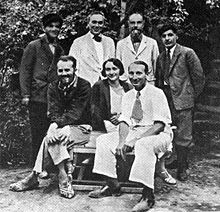Roman Ghirshman
This article needs additional citations for verification. (December 2009) |

Roman Ghirshman (Russian: Роман Михайлович Гиршман, Roman Mikhailovich Girshman; October 3, 1895 – 5 September 1979) was a Ukrainian-born French archeologist who specialized in ancient Persia.
A native of Kharkiv in the Sloboda Ukraine (present-day Ukraine) Ghirshman moved to Paris in 1917 to study Archeology and Ancient Languages. He was mainly interested in the archeological ruins of Iran, specifically , Teppe Sialk, Bagram in Afghanistan, Bishapur in Fars, and Susa.
In the 1930s, Girshman, together with his wife Tania Ghirshman, was the first to excavate Teppe Sialk. His studies on Chogha Zanbil have been printed in 4 volumes, and he also led excavation teams at Kharg Island, , and the Parthian platforms in Masjed Soleiman, near Izeh, Khuzestan.
With 300 papers and 20 books published, Ghirshman was one of the most prolific and respected experts on ancient Iran. Some of his works on Susa have not even been published yet, but have served other archeologists such as Jean Perrot and in subsequent follow-up studies in the 1960s and 1970s in Iran.
Honors[]
Selected works[]
In a statistical overview derived from writings by and about Roman Ghirshman, OCLC/WorldCat encompasses roughly 300+ works in 600+ publications in 12 languages and 6,000+ library holdings.[1]
- 1938, Fouilles de Sialk, prés de Kashan, 1933, 1934, 1937. Librairie Orientaliste , Paris (in two volumes).
- 1954, Iran: from the earliest times to the Islamic conquest. Penguin books.(A French version was published in 1951 by Payot, Paris).
- 1963, Perse. Proto-iraniens, Mèdes, Achéménides. Gallimard, Paris.
- 1970, Le Pazuzu et les fibules du Luristan. Impr. Catholique, Beirut.
- 1971, Persia, the immortal kingdom. (Coauthors: Minorsky, V.F., and , Greenwich, Conn., New York Graphic Society.
- 1976, L'Iran des origines à l'islam. Nouv. éd. rev. et mise à jour. Paris.
- 1977, L'Iran et la migration des Indo-Aryens et des Iraniens. Leiden.
- 1979, Tombe princière de Ziwiyé et le début de l'art animalier scythe. Soc. Iranienne pour la Conservation du Patrimoine, Paris.
Notes[]
- 1895 births
- 1979 deaths
- People from Kharkiv
- People from Kharkov Governorate
- Ukrainian Jews
- Ukrainian emigrants to France
- French archaeologists
- French Iranologists
- Members of the Académie des Inscriptions et Belles-Lettres
- 20th-century archaeologists
- Corresponding Fellows of the British Academy